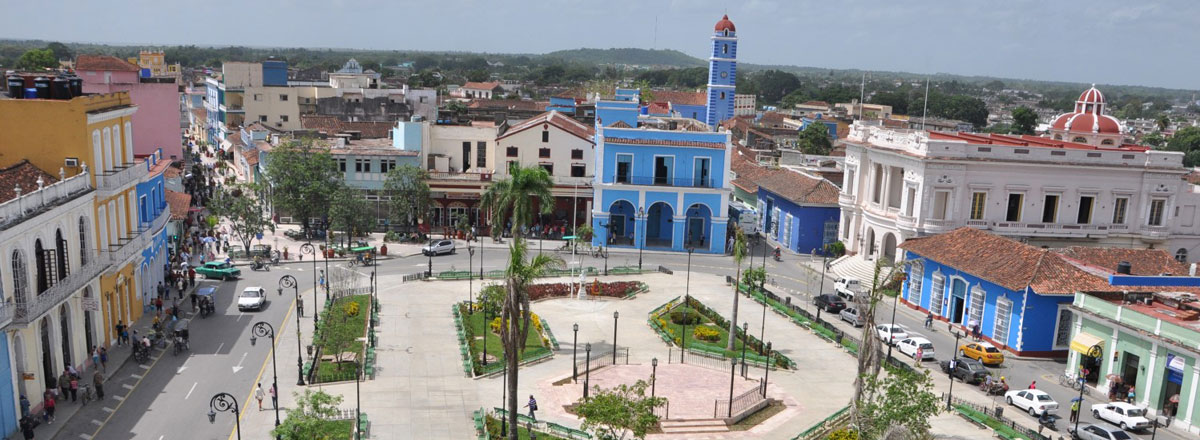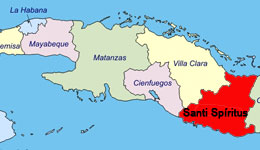Sancti Spiritus is the capital of the province of the same name. West to Sancti Spiritu is Villa Clara province while Cienfuegos and Ciego de Avila provinces are located on the eastern boundary. The city is mainly a flat territory and it was founded east to Yayabo River . You can reach this city from Havana on the National Highway and Central Road.
Originally known as the Villa del Espiritu Santo, it was the fourth among the first seven villas founded on the island in 1514 by Diego Velasquez and Fernando de Cordoba and it’s the only one with a Latin name. La Villa received the title of city in 1867.
The region’s main economic activities have been cattle and sugar cane cultivation. It is also located close to the Zaza Lake and also has important areas where tobacco leaf is grown.
Its symbol is the Yayabo Bridge built over the river of the same name and whose surroundings is the old city made up of beautiful colonial mansions among them the Quinta de Santa Elena.
Among the main places to visit is the Central Plaza or Serafin Sanchez Square in honor to the hero of the independence war against Spanish colonialism. The square is surrounded by neo-classic style buildings like the Library and Main Theater. You can also find the Oscar Moresa Art Gallery where you can find pieces of art of great value.
To the south you can find the country’s oldest churches, the Espiritu Santo Parish which dates back to 1680, live testimony of the villa’s old times. And last is the Colonial Art Museum, former Valle-Iznaga Palace that belonged to one of the richest families in Cuba.
The Espiritu Santo Villa is the home of very famous trovador singers who has contributed to the greatness of Cuban Music. If you are visiting the city a visitor must not leave town before visiting the Trova House.
Towards the outside areas of the city you can find the Escambray Mountains, one of the highest elevations on the island.
A must is Trinidad which has stopped in time and offers a visitor the extraordinary enchantments of a live city-museum enclave between the ocean and the mountains. This typical colonial city was declared a World Heritage Site by UNESCO in 1988. Trinidad has learned to combine its daily life with the countless riches since its foundation.

Things to do
Attractions
- ✓ Sancti Spiritus Provincial Museum.
- ✓ Oscar Fernandez Morera Gallery.
- ✓ Serafín Sanchez House-Museum.
- ✓ Espiritu Santo Church.
- ✓ Yayabo Bridge.
- ✓ Espiritu Santo Parroquial Church.
- ✓ Main Theater.
- ✓ Santa Elena Quinta.
- ✓ Carlos de la Torre Natural.
- ✓ Sciences Museum.
In the sorrounding area of Sancti Spiritus:
- ✓ Las Damas Sierra, Cabaiguan..
- ✓ Los Cerros in Fomento.
- ✓ Ethnographie Museum, Cabaiguan.
- ✓ Former homes in the Narciso Sugar Plantation, Yaguajay.
- ✓ Fomento Municipal Museum.
- ✓ Guayarua Punta Judas Cave.
- ✓ Humboldt Cave.
- ✓ Jatibonico Municipal Museum.
- ✓ Zaguanes Natural Park, Yaguajay.
- ✓ Chivos Cave.
Popular characters in the City of Sancti Spíritus
Francisquito what time is: Francisco Polanco Guerrero, better known by Francisquito, had a peculiar way of "giving the hour" and this made him a possibly unique human being. The locals say that when asked what time it was, it answered with such precision that even the exact minutes offered. Of course, the amazing thing is that he never used a clock, just a logic difficult to explain.
Restaurants.
- Cafe El Colga'o. 45 kinds of coffee
- Meson de la Plaza. Cuban typical food with live music
- Don Gaspar. Cuban and international cuisine
- Papo's Paladar . Specializing in seafood
- Taberna Yayabo. Spanish food & drinks.




